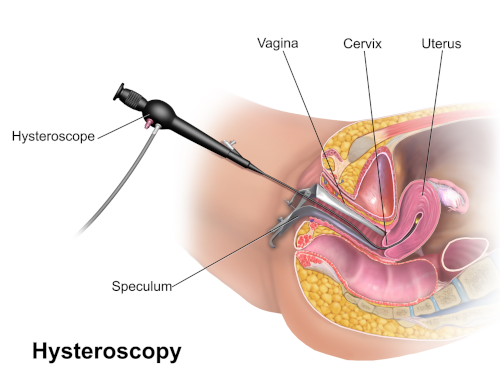What is Hysteroscopy?

When a woman suffers from excessive bleeding, painful periods, infertility, or recurrent miscarriages, the doctor needs to examine the uterine cavity. The procedure of examining the cervix and uterus using a hysteroscope is known as hysteroscopy. It is used both for diagnosis and operative purposes. It helps the doctor diagnose:
- Fibroids
- Endometrial Polyps
- Intrauterine Scar tissue or adhesions
- A bicornuate or septate uterus uterine malformations
- Other Uterine Problems
- In failed IVF for any uterine pathology
- Uterine septum
- Tubal block
- Allows direct visualization of the endometrial region to diagnose endometritis or adenomyosis
- Lesion in utero-tubal
Hysteroscope is a thin telescope kind of instrument, which the doctor inserts into the vagina to visualize the uterus cavity. It is a short day-care procedure taking about 30 minutes. When done for diagnosis, local anaesthesia is sufficient. In an operative case, the doctor uses general anaesthesia, and the patient may have to stay longer in the hospital.

What is operative hysteroscopy?
During diagnostic hysteroscopy, if fibroids, polyps, or scar tissue are detected, the doctor will expand the procedure to remove it with the help of operative instruments. Such a procedure is called operative hysteroscopy. Hence, operative hysteroscopy can treat many abnormalities found during diagnostic hysteroscopy.
What is hysteroscopic tubal cannulation?
A relatively new method for treating proximal tubal obstruction (cornual blocks, where the tubes are blocked at the utero-tubal junction) is that of hysteroscopic tubal cannulation. Many studies have shown that this kind of block is often because of mucus plugs or debris which plug the tubal lining at the utero-tubal junction which is as thin as a hair. It is now possible to pass a fine guidewire through the hysteroscope into the tubes, and thus remove the plug or debris and open the tubes – thus restoring normal tubal patency with minimally invasive surgery.
What are the risks of doing hysteroscopy?
When performed by experts, the chance of infection, uterine perforation, vaginal bleeding, and fluid overload is less.
How Does Hysteroscopy help in Infertility Treatments?
Hysteroscopy is precise with better visualization of the uterus compared to other procedures. Hence it is preferred by doctors, particularly for infertility treatments.
During infertility treatment, the doctor needs to examine the intrauterine changes that could interfere with the implantation or growth of the embryo. Hence, your doctor will recommend this procedure to you.